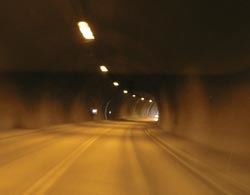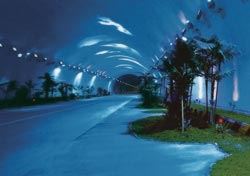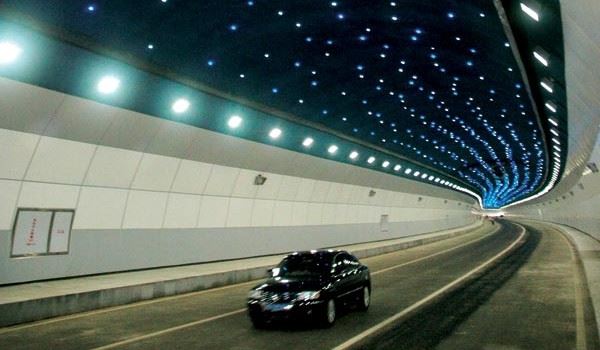Driving in tunnels is actually twice as safe as driving in the open,when all factors are taken into account,” says SINTEF scientist Gunnar Jensen. However, a rough estimate suggests that as many as 10 – 20 per cent of the population feel uncomfortable or very uncomfortable driving in tunnels. Older people in particular tend to feel insecure.

An irregularly lit road tunnel, where the illumination is primarily directed at the road surface. Studies have shown that a dark, monotonous tunnel is four times as unpleasant as a tunnel equipped with caverns, colours and patterns.
Photo: Henrik Undeland, Ramböll
Click to open
In a previous study carried out by SINTEF, as many as 40 per cent of the older age-group said that they felt extremely insecure driving in tunnels. They spoke of walls and road lanes that seemed to shrink, and of a feeling of being completely exhausted when they eventually reached the end of the tunnel.
Gunnar Jenssen believes that this may be due to the fact that elderly people tend to have poorer vision than younger people. This means that lighting conditions in tunnels play a decisive role in determining how people experience tunnels, he believes.
Design can reduce discomfort
Given this background, SINTEF transport researchers have been studying the use of various ranges of colour, lighting and patterns, as well as the use of cavern spaces in tunnels. The group’s driving simulator has been and still is a very useful aid in testing out lighting designs.
”The cavern in the tunnel is one measure that is high on our list. The trumpet-like widenings of the caverns’ entrances and exits are a way of breaking up the impact of long tunnels. The 24.5 km-long Lærdal Tunnel has three well-lit caverns designed according to proposals submitted by the Kadabra Produktdesign company, researchers and the artists Arild Juul and Brit Dyrnes.
Palm trees + clouds
In 2007, the lighting design from SINTEF was exported to China, and Gunnar Jenssen was project manager for “Safety and Lighting Design” when that coun-try inaugurated the world’s longest twin-tube tunnel, the Qinling Zhongnan Mountain Tunnel, in which the monotony is broken by huge caverns excavated at intervals of three to seven kilometres.

From the Qinling Zhongnan tunnel in China, where artistic lighting and the “Oasis with palms and clouds on the roof” design transformed an originally rather sterile and monotonous tunnel environment.
Photo: Road & Tunnel Management Center of Shaanxi Communication Bureau
Click to open
“The tunnel is 18×2 kilometres long, and to begin with it was a sterile, monotonous tunnel, which was then developed in collaboration with Norwegian artists and designers into an oasis with palmtrees and clouds on the roof ,” says Jenssen.
Lighting for safety
The main point is to make certain the light is well distributed, in conjunction with the use of artistic lighting, which turns out to give drivers a feeling of space and of greater security. Modern light-ing systems, with two rows of lamps, light sources that illuminate the opposite direction and driving lane, are beginning to be quite common in new Chinese tunnels, and they have also been installed in the tunnel that forms part of the Øresund Link between Denmark and Sweden.
By Åse Dragland

